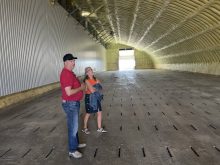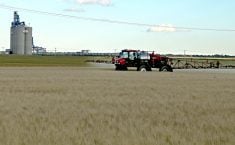After spending much of the past year on life support, the Western Canadian Wheat Growers Association is out of the hospital and ready to resume normal activities.
The right-of-centre farm lobby group suspended operations last summer in the face of drastically shrinking membership and a lack of money.
But a volunteer committee has been working hard to get the organization running again.
Those efforts will come to fruition in mid-March, when the association holds a convention in a yet-to-be determined city in Western Canada to affirm a new structure, elect officers and set policy.
Read Also

New coal mine proposal met with old concerns
A smaller version of the previously rejected Grassy Mountain coal mine project in Crowsnest Pass is back on the table, and the Livingstone Landowners Group continues to voice concerns about the environmental risks.
Judging by comments from some members involved in the re-organization effort, farmers should have no trouble recognizing the association.
“We’ve strongly represented the interests of commercial farmers in the past and those who believe in the marketplace, and that’s certainly going to continue,” said Paul Orsak, a Manitoba farmer and spokesperson for the renewal committee.
While the association’s policy thrust will remain the same, the committee members are hoping at least one thing will be different – the average age of the membership.
They say that convincing more young farmers to get involved will be crucial to the association’s future success.
One of those young members is Clayton Kotylak, a 37-year-old farmer from Montmartre, Sask., who has worked on the renewal committee.
He said the key is attracting the 20- to-40-year-old farmer who has a free market mentality.
“There’s lots of them out there now who have never been part of any farm policy lobby group,” he said.
“We need to get those energetic, young, go-getters into a room, call it a convention and hammer out some policy.”
Back in the early 1990s the wheat growers association boasted more than 10,000 members, due in large part to an aggressive ongoing recruitment program in the countryside.
The association was a high profile and sometimes influential proponent of deregulation and commercialization in the grain handling, transportation and marketing systems and a relentless critic of the Canadian Wheat Board.
As farm numbers declined and tough economic times forced farmers to focus more on day-to-day survival and less on policy debate, membership numbers began to decline precipitously, bottoming out at around 1,000 last year.
Nevertheless, last year’s decision by the former board of directors to resign, close down the office, lay off staff and wind down the association’s affairs shocked non-members and members alike, coming as it did on the heels of an apparently successful convention in Calgary.
But in retrospect, said Orsak, that decision may have saved the organization.
“There was a bit of shock therapy there maybe,” he said.
“A lot of people who saw the organization go to the edge of the precipice have come forward and said, ‘we need the wheat growers to continue to work, it’s important,’ and taken out a membership or given us money.”
Having said that, the membership rolls are still stuck around 1,000. Memberships are being renewed, but new ones aren’t being sold.
“We’re not getting new members right now, so we have to address that,” Orsak said.
One of the issues that has been debated within the renewal committee, and may surface at the upcoming convention, is whether the association should soften some of its policy stances to broaden its appeal and attract members from outside its traditional constituency. That constituency is described by Orsak as “commercial, business-minded farmers” but characterized by critics as right wing ideologues.
Kotylak said the organization has to be seen as a rational and credible voice for farmers while at the same time standing for a certain set of beliefs.
“There is a balance to be struck between being hard-line right wing and being soft and trying to appeal to the masses,” he said.
Aside from attracting more and younger members, another key issue is figuring out how to reduce the time demands on the organization’s elected leaders.
Orsak said some former presidents have reported spending more than 250 days a year on association business, much of it away from home.
Fewer farmers are willing or able to take that kind of time away from their family and business, so the workload must be reduced to encourage people to take on leadership positions.
The only way to do that is to turn over more of the work to staff, including much of the travel and lobbying that has traditionally been done by elected farmer officials.
In the past the approach was to have farmers take the lead in lobbying and public comments, in the belief that that’s who government and public wanted to hear from.
“But the reality is that can’t always happen,” Orsak said.
















